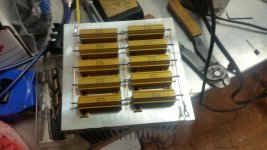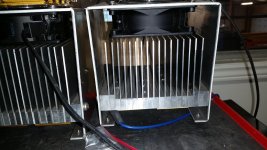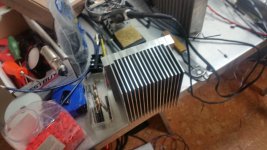hello diyaudio,
i am currently looking into methods of building a test load for when i repair and test higher power amps.
im looking for the following criteria :
-4-8 ohms changeable (2 ohm if possible)
-between 1500-2500w of dissipation (fans expected )
-must be able to handle 220v peaks (high rails of pa amps)
-survive short dc input (in case of output module breakdown
theese are the main criteria im looking for, but not limited to, some criteria could be tradedoff.
i found some 500w 16 ohm resistors that might work well for what i need, except the quantity needed to operate 2 ohms would be expensive.
i was also wondering if i could simply use heating elements as load?
would be rather easy to find a 2kw heater and strip the coils.
please let me know what you think or ideas that you might have.
-philippe
i am currently looking into methods of building a test load for when i repair and test higher power amps.
im looking for the following criteria :
-4-8 ohms changeable (2 ohm if possible)
-between 1500-2500w of dissipation (fans expected )
-must be able to handle 220v peaks (high rails of pa amps)
-survive short dc input (in case of output module breakdown
theese are the main criteria im looking for, but not limited to, some criteria could be tradedoff.
i found some 500w 16 ohm resistors that might work well for what i need, except the quantity needed to operate 2 ohms would be expensive.
i was also wondering if i could simply use heating elements as load?
would be rather easy to find a 2kw heater and strip the coils.
please let me know what you think or ideas that you might have.
-philippe
I started a Amp Load project several years ago but time and money created a delay so big that the whole project has been placed in the fridge.
I also had no cad software to draw the schematis and the pcb's.
Finding the correct heatsinks was a problem to as theses are a bit expensive.
And you need a fair amount of these.
Then the mechanical design was a huge problem. Business have evolved here in Belgium and there are several companies who are willing to produce the metal work.
To keep the costs down it isn't necessary to have a load of 2 KWatt for 2 or even 1 ohm. If the need is there to have a load with a higher power handling, a slave could be used and controlled by the main unit.
As resistors I intended to use the Caddock MP9000 series ( non inductive) with a value of 1 ohm. Two resistors mounted on a heatsink with a heatpipe and a ventilator coming from computers can easy handle 150 watts for a long long period. The temperature didn't rise above the 50° Celsius. I did the test.
The ventilator on the heatsinks are temperature controlled because they will make a lot of noise when there is a lot of power to dissipate.
The load resistance is switchable and this is done with a bit of logic and relais. Heavy duty ralais are a lot cheaper then multipole power switches.
Inputs are via Speakon connectors.
A meter is available for both channels, A and B so that the RMS voltage or power in watts can be measured.
Another meter is connected to the test signals so you know how much is sent into the amp under test.
Output connectors are available at the same time for a distortion meter and an osciloscope.
Of course a dc blocking circuit at the input of the load is needed in case an amp with DC on its output is connected.
Also an external speaker output with the full power should be available when the load is no longer needed after a test or repair.
A small monitor amp is included so the signal in the case of audio) can be heard.
Signal inputs are available with calibrated attenuators.
eg. Audio via rca connectors. Test signal from a generator via a jaxk or xlr. An instrument (guitar) via a jack for testing guitar amps.
These signals are available on an output that are injected in to the amp under test.
Other ideas were to ad an electronic sort of variac.
Whenever the current draw is to high it will either limit or switch of the ac power to the amp under test.
An switchable and intern or extern variac controlled ac output should be available at the front of the load unit.
Mounted in a 19" unit it looks very professional and that's the whole idea.
I have to scan my papers and make them available. Maybe with the contribution of others it can become a finished product.
And I know there are other possibilities with cheaper materials like washing machine resistors etc; but hey, don't you like to drive a Mercedes Benz?
I also had no cad software to draw the schematis and the pcb's.
Finding the correct heatsinks was a problem to as theses are a bit expensive.
And you need a fair amount of these.
Then the mechanical design was a huge problem. Business have evolved here in Belgium and there are several companies who are willing to produce the metal work.
To keep the costs down it isn't necessary to have a load of 2 KWatt for 2 or even 1 ohm. If the need is there to have a load with a higher power handling, a slave could be used and controlled by the main unit.
As resistors I intended to use the Caddock MP9000 series ( non inductive) with a value of 1 ohm. Two resistors mounted on a heatsink with a heatpipe and a ventilator coming from computers can easy handle 150 watts for a long long period. The temperature didn't rise above the 50° Celsius. I did the test.
The ventilator on the heatsinks are temperature controlled because they will make a lot of noise when there is a lot of power to dissipate.
The load resistance is switchable and this is done with a bit of logic and relais. Heavy duty ralais are a lot cheaper then multipole power switches.
Inputs are via Speakon connectors.
A meter is available for both channels, A and B so that the RMS voltage or power in watts can be measured.
Another meter is connected to the test signals so you know how much is sent into the amp under test.
Output connectors are available at the same time for a distortion meter and an osciloscope.
Of course a dc blocking circuit at the input of the load is needed in case an amp with DC on its output is connected.
Also an external speaker output with the full power should be available when the load is no longer needed after a test or repair.
A small monitor amp is included so the signal in the case of audio) can be heard.
Signal inputs are available with calibrated attenuators.
eg. Audio via rca connectors. Test signal from a generator via a jaxk or xlr. An instrument (guitar) via a jack for testing guitar amps.
These signals are available on an output that are injected in to the amp under test.
Other ideas were to ad an electronic sort of variac.
Whenever the current draw is to high it will either limit or switch of the ac power to the amp under test.
An switchable and intern or extern variac controlled ac output should be available at the front of the load unit.
Mounted in a 19" unit it looks very professional and that's the whole idea.
I have to scan my papers and make them available. Maybe with the contribution of others it can become a finished product.
And I know there are other possibilities with cheaper materials like washing machine resistors etc; but hey, don't you like to drive a Mercedes Benz?
that sounds like exactly what i need plus more!
i would very much like to see those papers if you decide to post them!
Sent from my SM-G920W8 using Tapatalk
i would very much like to see those papers if you decide to post them!
Sent from my SM-G920W8 using Tapatalk
I use four off 4r0 test loads, with 4mm banana plugs.
They can be assembled in many combinations from 1r0 to 16r.
Each 4r0 is made up from 45 off 20r 5W metal oxide in ceramic radial case.
and then each is fine trimmed to bring to as near exactly 4r0 as I am capable of measuring.
I did not choose the metal cased resistors as I believe they run the resistor element much hotter and thus suffer from increased error when warm/hot.
They can be assembled in many combinations from 1r0 to 16r.
Each 4r0 is made up from 45 off 20r 5W metal oxide in ceramic radial case.
and then each is fine trimmed to bring to as near exactly 4r0 as I am capable of measuring.
I did not choose the metal cased resistors as I believe they run the resistor element much hotter and thus suffer from increased error when warm/hot.
I use 5 ohm 225 W log resistors from dale, with pigtails soldered on with .250 flag terminals on them. This allows various series and parallel combinations. They are inductive, as are the speakers I use. They were $5 each from a surplus house. I have 8. I mount them on metal plates with tabs bent up to hold them up off the surface. I cut the plates out of old computer cases with a die grinder. If I were going that high in wattage, I'd put the logs in an old room heater frame with feet and a fan. Room heaters tend to have the tip over switch or thermostat wear out rather quickly. The big ones have a fan which tends to last.
The heating element of a room heater is useful for Mains ballast on 1500 watt amp for initial short test, but are too high in resistance for a load resistor.
The heating element of a room heater is useful for Mains ballast on 1500 watt amp for initial short test, but are too high in resistance for a load resistor.
Gee,
I'm pretty pedestrian when it comes to dummy loads. I have a pair of Dale metal 250 W resistors. I have another pair should I need 4 R at 500 W. They are on large heat sinks that I had milled level for the purpose.
I have measured them hot and cold. No real problems with resistance changes Andrew. Note that they must be mounted to large heat sinks to meet their rated power handling. The actual resistive elements are cooled effectively as these are filled with a grease, could be thermal compound. We saw one disassemble itself in my old shop. It was pretty funny, but it was hit with 2X its rated power for a period of time. The tech was just being told to shut down when the end slid out with a puff of smoke, then continued it's slow slide to the bench top.
-Chris
I'm pretty pedestrian when it comes to dummy loads. I have a pair of Dale metal 250 W resistors. I have another pair should I need 4 R at 500 W. They are on large heat sinks that I had milled level for the purpose.
I have measured them hot and cold. No real problems with resistance changes Andrew. Note that they must be mounted to large heat sinks to meet their rated power handling. The actual resistive elements are cooled effectively as these are filled with a grease, could be thermal compound. We saw one disassemble itself in my old shop. It was pretty funny, but it was hit with 2X its rated power for a period of time. The tech was just being told to shut down when the end slid out with a puff of smoke, then continued it's slow slide to the bench top.
-Chris
I use a huge speaker for a load and face the speaker downwards on carpet to damp out most of the sound. I also use a DC speaker protector circuit on the output in case of faults.
does anyone have any links to good deal on high power resistors?
I looked on Ebay and found that you can get 100W rated 1R power resistors for about $2.50 each. These can be screwed down to a heatsink (and should be for the full rating). If I was putting together a resistive test load I would just buy 16 of these that can be placed in series and/or parallel to give me a high power load. Make sure that these are the low/non-inductive type. Most high power resistors are wirewound ceramic embedded elements. By winding the wire in a certain way the inductance is mostly cancelled out. Otherwise you are limited to 3W or 5W metal film resistors and getting rid of the heat is not as easy since they are not designed to be heatsink mounted.
I did as CharlieLaub is suggesting with 10 50W resistors. Newark/Farnell has blowout sales regularly. The dump stock ridiculously cheap sometimes. That's where I bought mine.
Attachments
Get yourself a few of these, plus large glasses of water to put them in then you won't need any fans.
http://www.amazon.com/Boiler-Coffee-Immersion-Portable-Element/dp/B016PIFI0C/ref=pd_sim_79_3?ie=UTF8&dpID=411nnw5yOrL&dpSrc=sims&preST=_AC_UL160_SR160%2C160_&refRID=0F4FAA84D8G1JCWRA0SX
A quick calculation says as this is rated at 1.5kW its around 8 to 9 ohms. Get 4 and you'll be able to go almost down to 2ohms.
http://www.amazon.com/Boiler-Coffee-Immersion-Portable-Element/dp/B016PIFI0C/ref=pd_sim_79_3?ie=UTF8&dpID=411nnw5yOrL&dpSrc=sims&preST=_AC_UL160_SR160%2C160_&refRID=0F4FAA84D8G1JCWRA0SX
A quick calculation says as this is rated at 1.5kW its around 8 to 9 ohms. Get 4 and you'll be able to go almost down to 2ohms.
what would be the different of a heating load like this versus a resistor bank load? does the heating element chsnge impedance during its warmup?Get yourself a few of these, plus large glasses of water to put them in then you won't need any fans.
http://www.amazon.com/Boiler-Coffee..._UL160_SR160,160_&refRID=0F4FAA84D8G1JCWRA0SX
A quick calculation says as this is rated at 1.5kW its around 8 to 9 ohms. Get 4 and you'll be able to go almost down to 2ohms.
Sent from my SM-G920W8 using Tapatalk
so it seems that using heater coil is not uncommon.Check this one out:
Big Dummy Load Pro Sound Training
just a question of finding the right impedance
Sent from my SM-G920W8 using Tapatalk
Other thread with similar topic: http://www.diyaudio.com/forums/tubes-valves/284351-audio-dummy-load.html
thanks all for your input.
im having some ideas,
i was thinking of what heating elements i could use as loads, it seems they would have to be around 5000w @ 240v to be what im looking for.
i was thinking of other things that are high power that could maybe be used as loads.
i was thinking about maybe a transformer with shorted secondary?
i have a transformer that powered a (has taps for 100-240Vin)1500w arc lamp that isnt of use right now, could that make a load? or would the amps not like it because its too inductive?
im having some ideas,
i was thinking of what heating elements i could use as loads, it seems they would have to be around 5000w @ 240v to be what im looking for.
i was thinking of other things that are high power that could maybe be used as loads.
i was thinking about maybe a transformer with shorted secondary?
i have a transformer that powered a (has taps for 100-240Vin)1500w arc lamp that isnt of use right now, could that make a load? or would the amps not like it because its too inductive?
5000W @ 240V translates (same resistance) to about 1100W @ 115V.
you are totally right, i was focusing too much on the watts i guess.
When I was testing a amplifier power up controller I used an electric fire to load it.
It was rated at 2000watts at 240VAC.
It was rated at 2000watts at 240VAC.
- Status
- Not open for further replies.
- Home
- Amplifiers
- Solid State
- high power test load for amplifiers


